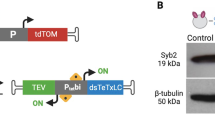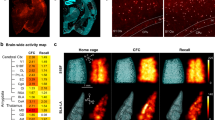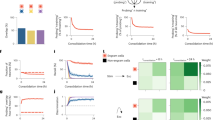Abstract
The dentate gyrus (DG) is important for encoding contextual memories, but little is known about how a population of DG neurons comes to encode and support a particular memory. One possibility is that recruitment into an engram depends on a neuron’s excitability. Here, we manipulated excitability by overexpressing CREB in a random population of DG neurons and examined whether this biased their recruitment to an engram supporting a contextual fear memory. To directly assess whether neurons overexpressing CREB at the time of training became critical components of the engram, we examined memory expression while the activity of these neurons was silenced. Chemogenetically (hM4Di, an inhibitory DREADD receptor) or optogenetically (iC++, a light-activated chloride channel) silencing the small number of CREB-overexpressing DG neurons attenuated memory expression, whereas silencing a similar number of random neurons not overexpressing CREB at the time of training did not. As post-encoding reactivation of the activity patterns present during initial experience is thought to be important in memory consolidation, we investigated whether post-training silencing of neurons allocated to an engram disrupted subsequent memory expression. We found that silencing neurons 5 min (but not 24 h) following training disrupted memory expression. Together these results indicate that the rules of neuronal allocation to an engram originally described in the lateral amygdala are followed in different brain regions including DG, and moreover, that disrupting the post-training activity pattern of these neurons prevents memory consolidation.
Similar content being viewed by others
Log in or create a free account to read this content
Gain free access to this article, as well as selected content from this journal and more on nature.com
or
References
Armbruster BN, Li X, Pausch MH, Herlitze S, Roth BL (2007). Evolving the lock to fit the key to create a family of G protein-coupled receptors potently activated by an inert ligand. Proc Natl Acad Sci USA 104: 5163–5168.
Berndt A, Lee SY, Wietek J, Ramakrishnan C, Steinberg EE, Rashid AJ et al (2016). Structural foundations of optogenetics: Determinants of channelrhodopsin ion selectivity. Proc Natl Acad Sci USA 113: 822–829.
Blanchard RJ, Blanchard DC (1969). Crouching as an index of fear. J Comp Physiol Psychol 67: 370–375.
Bolles RC, Fanselow MS (1982). Endorphins and behavior. Annu Rev Psychol 33: 87–101.
Buzsáki G (1989). Two-stage model of memory trace formation: a role for “noisy” brain states. Neuroscience 31: 551–570.
Carr MF, Jadhav SP, Frank LM (2011). Hippocampal replay in the awake state: a potential substrate for memory consolidation and retrieval. Nat Neurosci 14: 147–153.
Chawla MK, Guzowski JF, Ramirez-Amaya V, Lipa P, Hoffman KL, Marriott LK et al (2005). Sparse, environmentally selective expression of Arc RNA in the upper blade of the rodent fascia dentate by brief spatial experience. Hippocampus 15: 579–586.
Choi GB, Stettler DD, Kallman BR, Bhaskar ST, Fleischmann A, Axel R (2011). Driving opposing behaviors with ensembles of piriform neurons. Cell 146: 1004–1015.
Davis M (1992). The role of the amygdala in fear and anxiety. Annu Rev Neurosci 15: 353–375.
Dupret D, O’Neill J, Pleydell-Bouverie B, Csicsvari J (2010). The reorganization and reactivation of hippocampal maps predict spatial memory performance. Nat Neurosci 13: 995–1002.
Ego-Stengel V, Wilson MA (2010). Disruption of ripple-associated hippocampal activity during rest impairs spatial learning in the rat. Hippocampus 20: 1–10.
Girardeau G, Benchenane K, Wiener SI, Buzsáki G, Zugaro MB (2009). Selective suppression of hippocampal ripples impairs spatial memory. Nat Neurosci 12: 1222–1223.
Gouty-Colomer LA, Hosseini B, Marcelo IM, Schreiber J, Slump DE, Yamaguchi S et al (2016). Arc expression identifies the lateral amygdala fear memory trace. Mol Psychiatry 21: 364–375.
Guzowski JF, McNaughton BL, Barnes CA, Worley PF (1999). Environment-specific expression of the immediate-early gene Arc in hippocampal neuronal ensembles. Nat Neurosci 2: 1120–1124.
Han JH, Kushner SA, Yiu AP, Cole CJ, Matynia A, Brown RA et al (2007). Neuronal competition and selection during memory formation. Science 316: 457–460.
Han JH, Kushner SA, Yiu AP, Hsiang HL, Buch T, Waisman A et al (2009). Selective erasure of a fear memory. Science 323: 1492–1496.
Hernández-Rabaza V, Hontecillas-Prieto L, Velázquez-Sánchez C, Ferragud A, Pérez-Villaba A, Arcusa A et al (2008). The hippocampal dentate gyrus is essential for generating contextual memories of fear and drug-induced reward. Neurobiol Learn Mem 90: 553–559.
Hsiang WL, Epp JR, van den Oever MC, Yan C, Rashid AJ, Insel N et al (2014). Manipulating a “cocaine engram” in mice. J Neurosci 34: 14115–14127.
Jadhav SP, Kemere C, German PW, Frank LM (2012). Awake hippocampal sharp-wave ripples support spatial memory. Science 336: 1454–1458.
Ji D, Wilson MA (2007). Coordinated memory replay in the visual cortex and hippocampus during sleep. Nat Neurosci 10: 100–107.
Josselyn SA (2010). Continuing the search for the engram: examining the mechanism of fear memories. J Psychiatry Neurosci 35: 221–228.
Josselyn SA, Köhler S, Frankland PW (2015). Finding the engram. Nat Rev Neurosci 16: 521–534.
Kudrimoti HS, Barnes CA, McNaughton BL (1999). Reactivation of hippocampal cell assemblies: effects of behavioral state, experience, and EEG dynamics. J Neurosci 19: 4090–4101.
LeDoux JE (2000). Emotion circuits in the brain. Annu Rev Neurosci 23: 155–184.
Leutgeb JK, Leutgeb S, Moser MB, Moser EI (2007). Pattern separation in the dentate gyrus and CA3 of the hippocampus. Science 315: 961–966.
Liu X, Ramirez S, Pang PT, Puryear CB, Govindarajan A, Deisseroth K et al (2012). Optogenetic stimulation of a hippocampal engram activates fear memory recall. Nature 484: 381–385.
Maren S (2003). The amygdala, synaptic plasticity, and fear memory. Ann N Y Acad Sci 985: 106–113.
Marr D (1971). Simple memory: a theory for archicortex. Philos Trans R Soc Lond B Biol Sci 262: 23–81.
Nichols CD, Roth BL (2009). Engineered G-protein coupled receptors are powerful tools to investigate biological processes and behaviors. Front Mol Neurosci 2: 1–10.
Paxinos G, Franklin KBJ (2001) The Mouse Brain in Stereotaxic Coordinates, 2nd edn. Academic Press: San Diego, CA, USA.
O’Reilly RC, McClelland JL (1994). Hippocampal conjunctive encoding, storage, and recall: avoiding a trade-off. Hippocampus 4: 661–682.
Ramirez S, Liu X, Lin PA, Suh J, Pignatelli M, Redondo RL et al (2013). Creating a false memory in the hippocampus. Science 341: 387–391.
Reijmers LG, Perkins BL, Matsuo N, Mayford M (2007). Localization of a stable neural correlate of associate memory. Science 317: 1230–1233.
Rolls ET (2012). Advantages of dilution in the connectivity of attractor networks in the brain. Biologically Inspired Cognitive Architectures 1: 44–54.
Rubin DC, Umanath S (2015). Event memory: a theory of memory for laboratory, autobiographical, and fictional events. Psychol Rev 122: 1–23.
Russo SJ, Wilkinson MB, Mazei-Robison MS, Dietz DM, Maze I, Krishnan V et al (2009). Nuclear factor κB signaling regulates neuronal morphology and cocaine reward. J Neurosci 29: 3529–3537.
Sano Y, Shobe JL, Zhou M, Huang S, Shuman T, Cai DJ et al (2014). CREB regulates memory allocation in the insular cortex. Curr Biol 24: 2833–2837.
Schacter DL, Eich JE, Tulving E (1978). Richard Semon’s theory of memory. J Verbal Learning Verbal Behav 17: 721–743.
Sekeres MJ, Mercaldo V, Richards B, Sargin D, Mahadevan V, Woodin MA et al (2012). Increasing CRTC1 function in the dentate gyrus during memory formation or reactivation increases memory strength without compromising memory quality. J Neurosci 32: 17857–17868.
Semon R (1923) Mnemic Psychology. G. Allen & Unwin Limited: London.
Skaggs WE, McNaughton BL (1996). Replay of neuronal firing sequences in rat hippocampus during sleep following spatial experience. Science 271: 1870–1873.
Tatsuno M, Lipa P, McNaughton BL (2006). Methodological considerations on the use of template matching to study long-lasting memory trace replay. J Neurosci 26: 10727–10742.
Tonegawa S, Liu X, Ramirez S, Redondo R (2015). Memory engram cells have come of age. Neuron 87: 918–931.
Treves A, Tashiro A, Witter MP, Moser EI (2008). What is the mammalian dentate gyrus good for? Neuroscience 154: 1155–1172.
Vazdarjanova A, Ramirez-Amaya V, Insel N, Plummer TK, Rosi S, Chowdhury S et al (2006). Spatial exploration induces ARC, a plasticity-related immediate-early gene, only in calcium/calmodulin-dependent protein kinase II-positive principal excitatory and inhibitory neurons of the rat forebrain. J Comp Neurol 498: 317–329.
Wilson MA, McNaughton BL (1994). Reactivation of hippocampal ensemble memories during sleep. Science 265: 676–679.
Yassa MA, Stark CEL (2011). Pattern separation in the hippocampus. Trends Neurosci 24: 515–525.
Yiu AP, Mercaldo V, Yan C, Richards B, Rashid AJ, Hsiang HL et al (2014). Neurons are recruited to a memory based on relative neuronal excitability immediately before training. Neuron 83: 722–735.
Zhou Y, Won J, Karlsson MG, Zhou M, Rogerson T, Balaji J et al (2009). CREB regulates excitability and the allocation of memory to subsets of neurons in the amygdala. Nat Neurosci 12: 1438–1443.
Acknowledgements
We would like to thank Mika Yamamoto, Daisy Lin, Sherwin Nicholson, and Antonietta (Toni) Decristofaro for technical assistance.
Author information
Authors and Affiliations
Corresponding author
Rights and permissions
About this article
Cite this article
Park, S., Kramer, E., Mercaldo, V. et al. Neuronal Allocation to a Hippocampal Engram. Neuropsychopharmacol 41, 2987–2993 (2016). https://doi.org/10.1038/npp.2016.73
Received:
Accepted:
Published:
Issue date:
DOI: https://doi.org/10.1038/npp.2016.73
This article is cited by
-
Engram mechanisms of memory linking and identity
Nature Reviews Neuroscience (2024)
-
Peroxisome proliferator-activated receptor-α activation facilitates contextual fear extinction and modulates intrinsic excitability of dentate gyrus neurons
Translational Psychiatry (2023)
-
Locus coeruleus input-modulated reactivation of dentate gyrus opioid-withdrawal engrams promotes extinction
Neuropsychopharmacology (2023)
-
Formation and fate of an engram in the lateral amygdala supporting a rewarding memory in mice
Neuropsychopharmacology (2023)
-
Functional network of contextual and temporal memory has increased amygdala centrality and connectivity with the retrosplenial cortex, thalamus, and hippocampus
Scientific Reports (2023)



